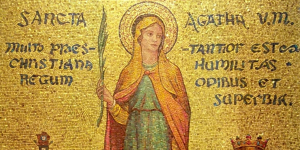
On February 5, we celebrate the Memorial of St. Agatha. Known for standing firm in her faith amidst intense persecution and physical torture, Agatha is recognized as the patroness of those suffering from breast cancer and disease. Today, we invite you to learn more about her life, legacy, and where she is portrayed in the Basilica.
Early Life
While there are limited historic accounts of Agatha’s life, it is believed that she was born near Mount Etna in Sicily to an affluent nobleman in approximately A.D. 235. As a young girl, she underwent the ritual of “velatio” (taking the veil) to mark herself as a virgin for Christ, and received a red veil to wear as a symbol of her promise.
Agatha grew into an accomplished young woman, and soon caught the eye of a Roman official named Quintian, who attempted to woo her. At this time, Christians in Italy were suffering from persecution under Emperor Decius. However, Agatha did not let fear dictate her decisions, and resolved to continue living married to Christ, spurning Quintian’s advances.
Faithful Through Suffering

Infuriated by Agatha’s rejection, the official did all in his power to make Agatha suffer for her faith. In an attempt to spoil her purity, he forced her to work in a brothel, but by God’s grace she remained unharmed. She was then returned to Quintian, who placed her on trial for her faith. Once again, she refused to deny Christ, and was subjected to an unnecessary mastectomy. Still Agatha did not waver in her belief, and was then sentenced to be stripped of all her clothes except her red veil and raked across burning coals. While she was being tortured, an earthquake occurred, and many townspeople rushed to the court and begged the officials to stop. Agatha was removed from the coals and returned to jail miraculously unharmed, with her veil still intact.
One account states that after this experience, she pleaded with the Lord to take her to heaven, declaring:
“You Lord, who have created and guarded me from my childhood, and made me to act with manly strength, have taken from me the love of the passing world, who kept my body from contamination, who made me overcome the torments of the executioner, the iron, the fire, and the chains, who gave me in torment the virtue of patience! Please accept my spirit now, for it is already time that I should leave this world by your command and reach your mercy.”
On that day, February 5, A.D. 251, the Lord answered her prayer and took her home.
Saint Agatha’s Legacy
A year after her death, Mount Etna erupted, wreaking havoc on the city below. Remembering Agatha’s faithfulness during her life, the villagers begged her to intercede on their behalf. According to Catholic tradition, they laid her veil on the ground in front of the flowing lava, and it miraculously stopped.
Today, you can find St. Agatha portrayed in a chapel in the West Apse of the Crypt Church of the Basilica. View the chapel for yourself in stunning 360° with our virtual tour below!
Sources:
The Basilica Guidebook, Dr. Geraldine Rohling
St. Agatha, Virgin and Martyr, Vatican News
Saint Agatha, Franciscan Media
Light a Candle at the Basilica
 In honor of St. Agatha, we invite you to light a candle today at the National Shrine. Vigil candles burn in the chapels throughout the Great Upper Church and lower crypt level of the National Shrine. Each candle represents the faith of the supplicants and their fervent prayers entrusted to the loving intercession of the Blessed Mother.
In honor of St. Agatha, we invite you to light a candle today at the National Shrine. Vigil candles burn in the chapels throughout the Great Upper Church and lower crypt level of the National Shrine. Each candle represents the faith of the supplicants and their fervent prayers entrusted to the loving intercession of the Blessed Mother.

